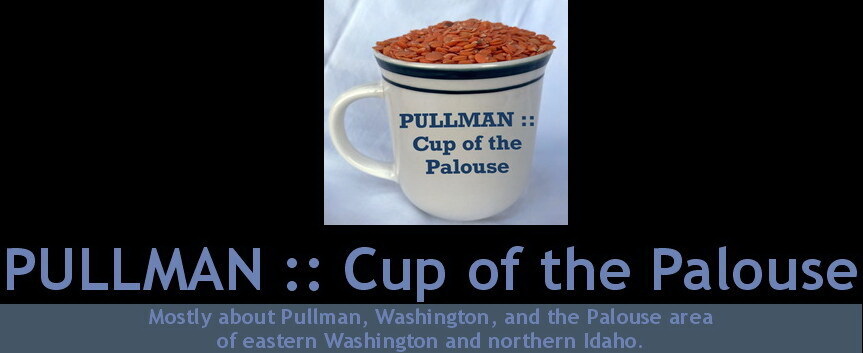The life and times of N. S. Golding, lead researcher for WSU’s famous ‘Cougar Gold Cheese’
June 2014
http://creamery.wsu.edu/about-us/drgolding
Since Cougar Gold Cheese from the Washington State University (WSU) Creamery in Pullman, WA, was developed in the 1930’s and 1940’s, its production, sales and fame have increased over the years.
But, cheese namesake Norman Shirley Golding is not as famous as the cheese he helped develop as lead researcher at what was then Washington State College (WSC).
For the record, the name “Cougar Gold,” honoring Norman Golding and Butch, WSU’s cougar mascot, was the result of a campus-wide contest, according to the Spokane Chronicle.
The youngest of 13 children, nine of whom survived to adulthood, Norman was born Feb. 13, 1889, in the village of Plaxtol in the south of England in Kent (county). His parents were Sarah (“Sally”) Barton Golding and Thomas Golding.
In the photo included in this story, Norman appears on the far right. On the far left is eldest brother, Jack, a prominent person in England, serving as a Midlands college professor before World War I. After the war, Jack was the first head of the Chemistry and Bacteriology Department of the National Dairy Research Station. (Read more about Jack later in this story.) Two brothers farmed in Canada, two brothers served in the navy. Another died serving in the British army during World War I.
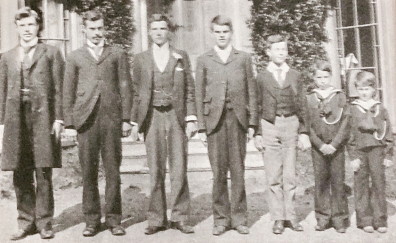
Norman said in 1791 a Golding family member selected a hop which is the parent hop to more than half of the hops grown on the Pacific Coast in the U.S. and Canada. One establishment still serving beer made with Golding hops is Plaxtol’s Golding Hop pub. Golding family members have each enjoyed a pint or two there.
In his youth, until 12 years of age, Norman and three younger cousins were taught by his older sister Mabel at the family home, known as the Tree House. Then, he attended Sevenoaks (Kent) Grammar School until he was 15 years old. For about a year, he was ill and had little schooling. Finally, he studied for two years–graduating in 1907–from Retford Grammar, a boarding school in Nottinghamshire (county) in England’s Midlands.
This was followed by two years at Midland Agricultural College, part of the University of Nottingham, where he earned, as a member of the university’s first graduating class, a first-class diploma and passed Royal Agricultural Society examinations in agriculture and dairying.
After several months seeking a job, he went to work in 1910 for a Derbyshire milk factory. One of the factory’s accounts was Cadbury’s chocolate. Fulfilling the needs of the chocolate company required 100,000 pounds of milk a day, six days a week. Norman earned 30 shillings for 80 hours a week, and he got one Sunday off after working nine months.
Norman moved in late 1910 to Canada, joining his two older brothers in Ontario. He obtained a junior teaching post at Ontario Agricultural College in Guelph and also did research ($50 a month) while working on his bachelor of science in agriculture degree (earned in 1914).
One of Norman’s responsibilities at the college was teaching a class of 12 women who were about his age. He had never taught before and knew little about the subject he taught. However, he found the students to be “quite cooperative, but judged they were more interested in my accent” than the class subject.
He met his future wife Marion (May) Hill, who worked in the college’s poultry science department.
In 1914, the Canadian and U.S. governments increased agriculture education funding to fulfill the need for those trained in agriculture. Having a pick of schools in which to study, Norman selected Iowa State University in Ames, Iowa, and studied there from June of that year until January 1915.
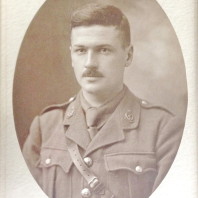
After six months, his regiment traveled as part of the Canadian Expeditionary Force to England and spent six months camped out. During that time he was promoted to corporal. “All I saw of war in 1915 were German Zeppelins (dirigibles/blimps) flying toward London to drop bombs,” he wrote.
In January 1916 he was commissioned a first lieutenant in England’s Royal Army Medical Corps Territorial Force. Because the British army had a shortage of medical doctors, he qualified for sanitation training with his degree in bacteriology. After three months training in London, he took command of a London Sanitary Company unit of 27 soldiers and one officer and later was promoted to captain.
Just after Christmas in 1916, Norman and May married in a Plaxtol church. May came over from Canada by ship with a convoy. While he served, she lived at Tree House and took jobs to help the war effort. One duty was counting hay bales loading for shipment to France to feed British army horses.
Norman and May had two months together before his division moved to the Bethune area of France where he helped lead efforts dealing with water supplies, sewage (including dealing with manure from army horses), filtration and chlorination of water. Typhoid was a major problem. Unlike British and Canadian troops, French soldiers were not inoculated and suffered many more illnesses and deaths as a result. Sanitary sections helped reduce mortality from disease. Because two or three men in each British army section were trained in filtration and chlorination of water, the results were healthy British soldiers, a spectacular contrast to French troops.
Some of Norman’s military time was spent serving with his eldest brother, John (“Jack”) Golding, a British Army colonel and a chemist. Initially in London, the brothers Golding spent the later years of their military service in northern France. They developed a structure to kill bed bugs, lice fleas and other pathogen in blankets, mattresses, uniforms and other things. They also helped disband the British army after the war ended November 11, 1918.
Following the war, Norman remained in France several months to help deal with the fact the Germans left Tournai, Belgium, in “very bad sanitary shape, piles of garbage on every corner, a huge pile of fermenting horse manure with accompanying house flies in the middle of cavalry barracks.” When the work in Tournai was well under way, Norman was transferred as chief instructor to the fifth Army Agricultural School for three months in Calais. There he provided agricultural training to soldiers before they returned to civilian life. Norman served in the British army until discharge in May 1919.
While World War I was deadly, good fortune kept Norman from death or injury. Not being sent into combat in France was a stroke of luck. Once he was near where German troops were shelling and advancing. Things looked bleak. But, hungry German soldiers stopped their advance to raid their officers’ food supply. That gave British troops time to escape. Another time another captain lost his life when a German bomb hit the captain’s tent. Norman said his greatest point of pride while serving in the Royal Army was not losing a soldier under his military command.
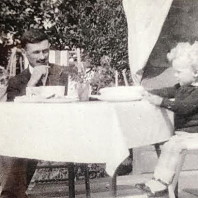
While May and Tom stayed in Ontario, Norman traveled to the University of British Columbia (UBC) in Vancouver, B.C. For 17 months, he taught former soldiers, returned from the war through the Soldiers Civic Reestablishment Program (SCR). The focus of the SCR was teaching agricultural skills for use in civilian life. Norman taught how to make cheese.
Following Norman’s SCR duties, May and Tom joined him in Vancouver after he became a member of the UBC faculty. Also, for six summers he attended graduate school at Iowa State University, earning a master of science degree in 1924 and a doctoral degree in 1929, both degrees in dairy mycology.
In 1932 as a ramification of Depression economic woes, Norman lost his job when the UBC agricultural department suffered a 66 percent budget cut.
Well known and qualified, Norman was hired for a fill-in position at WSC in Pullman while a faculty member and Iowa State University graduate, Hans Bendixen, dairy science professor, was on leave, 1932-1933.
After Bendixen returned, Norman went across the border from Pullman to Moscow, Idaho, to the University of Idaho (UI). During the 1933-1934 academic year, he filled in while Donald Theophilus, UI associate professor of dairying who later became UI president, was on leave completing his doctoral degree at Iowa State.
In October 1934, Norman returned to WSC as an associate professor and later became professor in its dairy program.
In Pullman the Golding family lived on College Hill. Tom attended and graduated from Pullman High School and WSC (Bachelor of Science, 1939). In 1943 he earned a medical doctor degree from McGill University, Montreal.
During Norman’s WSC tenure (1934-1955), he discovered how to can cheese without carbon dioxide building up and exploding cans. At that time before plastic (shrink-wrap, sealed bags etc…) was used to package food items, cheese was commonly encased in wax. But, the wax often cracked. When WWII started, the U.S. government and the American Can Company helped fund Norman’s research, assisted by undergraduate and graduate students.
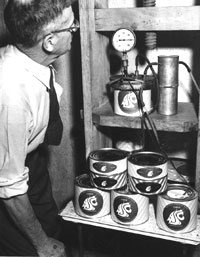
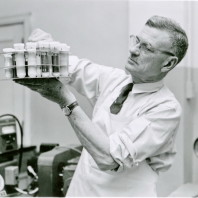
Looking back on his time at WSC/WSU, Norman said his research and working with undergraduate and grad students, faculty and staff was “congenial, helpful and cooperative” and “rewarding.”
May died in Pullman in 1961 after a long illness. When Norman left Pullman in the mid-1960s, he moved to Victoria, British Columbia with second wife E. Louise Nasmyth Golding, a retired WSC music faculty member. After Louise died in Victoria, Norman married Margery Excell Golding, a nurse. She soon became ill and succumbed several years later.
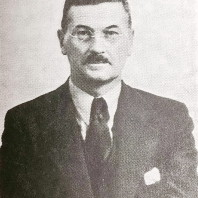
His grandchildren have fond memories of their grandfather, whom they called “the Professor.” They speak of his pronounced British accent, sense of humor and hearty laugh, his 6-foot height, his mustache, the eyeglasses he wore, the fact he always smoked a pipe, played golf and liked to swim, fish, travel and read (especially British authors) and drank scotch.
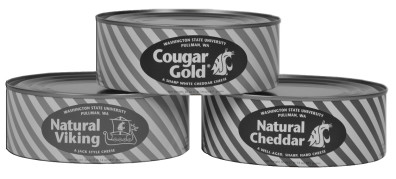
SOURCES FOR THIS ARTICLE include Dr. Tom Golding, a “Palouse Profile” from the July 11, 1968, issue of the Pullman Herald; a letter written by Norman and his brief autobiography, “How I survived to 89 years of Age;” and an article about him from the March 29, 1979, Victoria, B.C., Times. Other sources include WSU Hill Topics, Manuscripts, Archives and Special Collections, Washington State University Libraries; and Russ Salvadena and Marc Bates, respective manager and former manager of the WSU Creamery.
Writer/researcher/photographer Tim Marsh is a former Pullman resident now living in McMinnville, OR. Retired after more than 26 years at WSU, he worked for the university’s news and information service.
Photos #1, #2 and #3 from Dr. Tom Golding. Photos #4 and #5 from Manuscripts, Archives and Special Collections, Washington State University Libraries.
